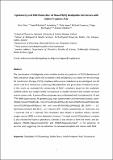| dc.contributor.author | Tolan, Dina | |
| dc.contributor.author | Almotairy, Awatif Rashed Z. | |
| dc.contributor.author | Howe, Orla | |
| dc.contributor.author | Devereux, Michael | |
| dc.contributor.author | Montagner, Diego | |
| dc.contributor.author | Erxleben, Andrea | |
| dc.date.accessioned | 2019-06-05T08:46:52Z | |
| dc.date.issued | 2019-04-19 | |
| dc.identifier.citation | Tolan, Dina, Almotairy, Awatif Rashed Z., Howe, Orla, Devereux, Michael, Montagner, Diego, & Erxleben, Andrea. (2019). Cytotoxicity and ROS production of novel Pt(IV) oxaliplatin derivatives with indole propionic acid. Inorganica Chimica Acta, 492, 262-267. doi: https://doi.org/10.1016/j.ica.2019.04.038 | en_IE |
| dc.identifier.issn | 0020-1693 | |
| dc.identifier.uri | http://hdl.handle.net/10379/15210 | |
| dc.description.abstract | The coordination of biologically active moieties to the axial positions of Pt(IV) derivatives of Pt(II) anticancer drugs allows the co-delivery and simultaneous activation of two pro-drugs for combination therapy. Pt(IV) complexes with a redox modulator as an axial ligand can kill cancer cells by a mechanism combining DNA platination and generation of oxidative stress. In this study we evaluated the cytotoxicity of Pt(IV) complexes based on the oxaliplatin scaffold and the pro-oxidant indole-3-propionate in cisplatin-sensitive and cisplatin-resistant ovarian cancer cells. A series of five complexes was synthesized and characterized by H-1 and Pt-195 NMR spectroscopy, IR spectroscopy, mass spectrometry and elemental analysis; trans-[Pt(DACH)(ox)(IPA)(OH)] (1), trans-[Pt(DACH)(ox)(IPA)(2)] (2), trans-[Pt(DACH)(ox)(IPA)(bz)] (3), trans-[Pt(DACH)(ox)(IPA)(suc)] (4), and trans-[Pt(DACH)(ox)(IPA)(ac)] (5) (DACH = 1,2-diaminocyclohexane (1R, 2R)-(-), ox = oxalate, IPA = indole 3-propionate, bz = benzoate, suc = succinate and ac = acetate). The complexes were shown to produce cellular reactive oxygen species (ROS) in a time-dependent manner. The most potent ROS producer, complex 1, also elicited the highest cytotoxicity. Complex 1 was shown to form the mono-and bis-adducts [Pt(DACH)(guanosine)( OH)](+) and [Pt(DACH)(guanosine)(2)](2+) in the presence of ascorbic acid, suggesting that on activation the released oxaliplatin will interact with DNA. | en_IE |
| dc.description.sponsorship | A.A. acknowledges a PhD scholarship from Taibah University. D.T. acknowledges the Egyptian Ministry of Higher Education (MoHE) for funding her re search stay at the National University of Ireland Galway. | en_IE |
| dc.format | application/pdf | en_IE |
| dc.language.iso | en | en_IE |
| dc.publisher | Elsevier | en_IE |
| dc.relation.ispartof | Inorganica Chimica Acta | en |
| dc.rights | Attribution-NonCommercial-NoDerivs 3.0 Ireland | |
| dc.rights.uri | https://creativecommons.org/licenses/by-nc-nd/3.0/ie/ | |
| dc.subject | Oxaliplatin | en_IE |
| dc.subject | Pt(IV) prodrugs | en_IE |
| dc.subject | Redox stress | en_IE |
| dc.subject | Indole propionic acid | en_IE |
| dc.subject | Cytotoxicity | en_IE |
| dc.subject | PLATINUM(IV) COMPLEXES | en_IE |
| dc.subject | CISPLATIN | en_IE |
| dc.subject | CANCER | en_IE |
| dc.subject | PRODRUG | en_IE |
| dc.subject | DESIGN | en_IE |
| dc.subject | AGENTS | en_IE |
| dc.title | Cytotoxicity and ROS production of novel Pt(IV) oxaliplatin derivatives with indole propionic acid | en_IE |
| dc.type | Article | en_IE |
| dc.date.updated | 2019-05-30T11:42:16Z | |
| dc.identifier.doi | 10.1016/j.ica.2019.04.038 | |
| dc.local.publishedsource | https://doi.org/10.1016/j.ica.2019.04.038 | en_IE |
| dc.description.peer-reviewed | peer-reviewed | |
| dc.contributor.funder | Taibah University PhD scholarship | en_IE |
| dc.contributor.funder | Egyptian Ministry of Higher Education (MoHE) | en_IE |
| dc.description.embargo | 2021-04-19 | |
| dc.internal.rssid | 16268994 | |
| dc.local.contact | Andrea Erxleben, School Of Chemistry, Room 150, Arts/Science Building, Nui Galway. 2483 Email: andrea.erxleben@nuigalway.ie | |
| dc.local.copyrightchecked | Yes | |
| dc.local.version | ACCEPTED | |
| nui.item.downloads | 58 | |


